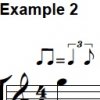The counting part of this is really kicking my arse.
I am used to the usual 1&2&3&4& style of counting, which is then further subdivided to 1e&2 or 1e&a2, or whatever is needed. But trying to count 1&a and play on the '1' and the 'a' is kicking my butt.
I get why Griff suggests this, but is it absolutely necessary? Could one get by just as well following the traditional counting method? Or should I just stick to it for as long as it takes to get this down? And if so, how would this counting method then be applied to other styles of music that one might want to play (rock, etc.)?
I am used to the usual 1&2&3&4& style of counting, which is then further subdivided to 1e&2 or 1e&a2, or whatever is needed. But trying to count 1&a and play on the '1' and the 'a' is kicking my butt.
I get why Griff suggests this, but is it absolutely necessary? Could one get by just as well following the traditional counting method? Or should I just stick to it for as long as it takes to get this down? And if so, how would this counting method then be applied to other styles of music that one might want to play (rock, etc.)?

